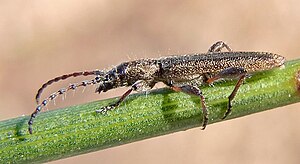Deilus fugax
| Deilus fugax | ||||||||||||
|---|---|---|---|---|---|---|---|---|---|---|---|---|

Deilus fugax |
||||||||||||
| Systematics | ||||||||||||
|
||||||||||||
| Scientific name | ||||||||||||
| Deilus fugax | ||||||||||||
| ( Olivier , 1790) |

|
|
|
Fig. 1: Alignment of the hairs on the elytric shields on the left with thick white hairs |
Fig. 2: Puncturing of the pronotum below (corresponds to the rear) more densely |

|
|
| Fig. 3: Mating | |
Deilus fugax is a beetle from the family of longhorn beetles . The generic name Deilus (at Reitter Dilus ) is from old Gr . "δειλος dēīlos" derived for "weak, fearful". The specific epithet fugax comes from the Latin "fúgax" for "volatile". Both names indicate that the beetle flees quickly when alarmed.
Characteristics of the beetle
The body is flat and elongated. It is clearly dotted everywhere and mostly inconspicuously gray-green or bronze-colored. The base of the antennae and leg links is reddish brown or these links are completely black. The label is covered with white hairs (Fig. 1), the rest of the body has long, non-lying gray hairs. The body length of the beetle is between six and eleven millimeters.
The protruding eyes are finely faceted, the individual eyes can only be seen when magnified more than ten times. They are cut out strongly kidney-shaped, almost divided. Their distance from one another on the apex is smaller than the distance between the bases of the antennae. The eleven-part feelers are robust and slightly thickened towards the tip. In the male they reach about the middle of the elytra, in the female they are hardly shorter. The first antenna segment is large, the second very short.
The pronotum is longer than it is wide and widened angularly in the middle, but without a hump. At the widest point it is still narrower than the elytra together on the shoulders. It is narrowed a little more towards the front and the puncture is denser at the back (Fig. 2).
The flattened elytra are parallel in front, they narrow a little towards the back. At the end, each one ends in a point. Behind the shoulders a little pronounced keel-shaped raised longitudinal rib begins, which disappears towards the rear. The seam is raised. The hair on the wing cover runs across (Fig. 1).
The front hips are spherical, their joint cavities are closed at the back. The thighs are thickened towards the tip. The tarsi appear to be four-limbed because the penultimate tarsi is difficult to see at the base of the claw limb.
biology
The larva of the thermophilic species develops in various yellow-flowered shrubs from the butterfly family , for example goat clover and broom . In Spain the adults are found between February and July. In Central Europe, the species can be found on flowers or on the breeding plants in May and June.
The males die just a few days after their appearance. The females lay the eggs in diseased or recently dead branches. The first larval stage hatches after just under two weeks. The larvae live under the bark and penetrate the center of the branch axis to pupate. They always slip through the dead end of the branch.
distribution
The occurrence of the species is limited to Europe. The center of the distribution area is in southern Europe and south-eastern central Europe, to the east it extends to central Russia and southern Russia .
literature
- Heinz joy, Karl Wilhelm Harde, Gustav Adolf Lohse (ed.): The beetles of Central Europe . tape 9 . Cerambycidae Chrysomelidae . Spektrum Akademischer Verlag, Munich 1999, ISBN 3-8274-0683-8 (first edition: Goecke & Evers, Krefeld 1966).
- Edm.Reitter: Fauna Germanica, the beetles of the German Empire, Volume IV, KGLutz 'Verlag, Stuttgart 1912
Individual evidence
- ↑ a b Deilus fugax at Fauna Europaea. Retrieved December 24, 2011
- ↑ Edm.Reitter: Fauna Germanica, the beetles of the German Reich . IV band KGLutz 'Verlag, Stuttgart 1912 Page 30
- ↑ Sigmund Schenkling: Explanation of the scientific beetle names.
- ↑ J. Navarro, JM Urbano, A Llinares: " Deilus fugax (Olivier 1790) Especie presente en Sevilla (Andalucía Espáña)" as PDF

